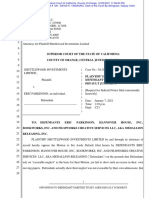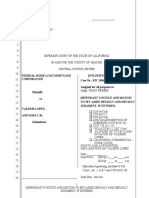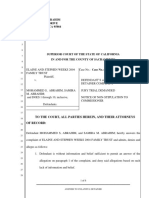Motion To Strike
Motion To Strike
Uploaded by
anon_410533234Copyright:
Available Formats
Motion To Strike
Motion To Strike
Uploaded by
anon_410533234Original Title
Copyright
Available Formats
Share this document
Did you find this document useful?
Is this content inappropriate?
Copyright:
Available Formats
Motion To Strike
Motion To Strike
Uploaded by
anon_410533234Copyright:
Available Formats
1 2 3 4 5 6 7 8 9 10 11 12 13 14 15 16 17 18 19 20 21 22 23 24 25 26 27 28
AMIR AFSHARKIAN 4726 Park Granada, Unit 215 Calabasas, CA 91302 DEFENDANT IN PRO PER
SUPERIOR COURT OF THE STATE OF CALIFORNIA COUNTY OF LOS ANGELES-VAN NUYS COURTHOUSE
) ) Plaintiff, ) ) vs. ) ) ) AMIR AFSHARKIAN, an individual; All others ) in possession; DOES 1 through 20, inclusive, ) ) ) Defendant, ) ) ) ) ) WELLS FARGO BANK
Case No.: 12B03446
MOTION TO STRIKE OF PLAINTIFFS COMPLAINT; MEMORANDUM OF POINTS AND AUTHORITIES IN SUPPORT THEREOF
TO THE COURT, ALL PARTIES HEREIN, AND THEIR ATTORNEYS OF RECORD: Defendant, AMIR AFSHARKIAN, (hereinafter Defendant ) hereby files his Motion to Strike the Unlawful Detainer Complaint for skipping the requirements of Code of Civil Procedure section 396(a) and failed to comply with the statutory requirements of California laws. MEMORANDUM OF POINTS AND AUTHORITIES I 1. 2. STATEMENT OF FACTS Plaintiff complaint follows an invalid foreclosure sale of the property owners real property. Defendant is a tenant and resides at the property and has a valid rental lease agreement
between the real party in interest who is the original owner of the property.
DEFENDENTS MOTION TO STRIKE
1 2 3 4 5 6 7 8 9 10 11 12 13 14 15 16 17 18 19 20 21 22 23 24 25 26 27 28
II 3. There is no verified Complaint on file with this Court. See: Memorandum of Points and
Authorities Attorney for Plaintiff, Ruzicka & Wallace LLP/Dess Richardson, is a debt collector and cannot represent a third party. MEMORANDUM OF POINTS AND AUTHORITIES 4. There is no verified Complaint on file with this court, therefore, Plaintiff never pleaded with
standing or sufficiency. Our Supreme Court has said in Silcox v. Lang (1889) 78 Cal. 118, 122: The practice of attorneys verifying for their clients should be discouraged, and to that end, the provisions of the Code should receive a strict construction. Applying such a construction, Code of Civil Procedure 446 does not authorize attorney verifications where absence of the party creates no inability on his part to verify. 5.
DeCamp v. First Kensington Corp. (1978) 83 Cal. App. 3d 268, 275: this mandatory
language is not applicable only when the attorney verification is in bad faith. A leading treatise states: The Courts have construed CCP 446 to permit attorney verification only
where the clients absence from the county makes it impractical or impossible to obtain the clients signature (emphasis mine). If the client can be reached by mail, no such impossibility existsand the attorney verification is not allowed! [DeCamp v. First
Kensington Corp.(1978) 83 Ca. 3d 268, 275, 157 CR 869, 873verification of answer]. Plaintiff has never alleged that the proper party was impossible to reach, especially by mail, and therefore, is barred from such a Verification as has been presented in their Complaint and signed by Dess Richardson as attorney of record. 6.
Weil & Brown, California Practice Guide: Civil Procedure Before Trial(Rutter Group
2010) Ch. 6-b, Par. 6:323: Where Plaintiff cannot show that absence from the county renders Plaintiff unable to verify complaint, a proper party verification is required.
DEFENDENTS MOTION TO STRIKE
1 2 3 4 5 6 7 8 9 10 11 12 13 14 15 16 17 18 19 20 21 22 23 24 25 26 27 28
7.
Plaintiffs attorney has never evidenced before this court a proper verification and is standing
under color of law by claiming it is moving on behalf of a third party. See: Heintz v. Jenkins
(1995) 514 US 291, 299. A debt collector is moving an action on its own behalf and in its
own interest and cannot represent a third party. In a County court, wherein the rights to property are determined, the debt collector, Ruzicka & Wallace, LLP., is moving a legal action in direct violation of Title 15 USCA Ch. 41 part V 1692i(b). A debt collector moved an initial communication to collect a debt (Notice to Vacate, January 4th, 2010). See: Goldman v. F
Cohen 445 F3d 152 (2006).
8. There is no verified Complaint on file with this court, therefore, Plaintiff never pleaded with
standing or sufficiency. Our Supreme Court has said in Silcox v. Lang (1889) 78 Cal. 118, 122: The practice of attorneys verifying for their clients should be discouraged, and to that end, the provisions of the Code should receive a strict construction. Applying such a construction, Code of Civil Procedure 446 does not authorize attorney verifications where absence of the party creates no inability on his part to verify. 9. Since Plaintiff has no valid execution of authority by its false filings at the County and
through its misrepresentations as to whom they represent to this court, the case itself cannot be classified as a Limited Case by statue. Defendant would be harmed in the amount of over $50,000.00 and this amount exceeds the limited jurisdiction of this court. Cal. Code of Civil Procedure 86(a)(1)et. Seq., Cal. Civil Code 1788.15(a) No debt collector shall collect or
attempt to collect a consumer debt by means of judicial proceedings when the debt collector knows that service of process, where essential to jurisdiction over the (alleged) debtor or his property, has not been legally effected.
10. The debt collector, Dess Richardson, has no legal authority to claim it is the legal
representative for a third party. Wilson v. Draper & Goldberg PLLC 443 F.3d 373 (2006). The
DEFENDENTS MOTION TO STRIKE
1 2 3 4 5 6 7 8 9 10 11 12 13 14 15 16 17 18 19 20 21 22 23 24 25 26 27 28
debt collector in this matter is Robert J. Jackson & Assoc., Inc., and has no standing. Therefore, they must be enjoined from any actions in furtherance of dispossessing 4726 Holding Trust of its property. See: State ex rel. State Bar of Wisconsin v. Bonded Collections Inc., 36 Wis. 2d 643
(1967), Carroll v. Wolpoff & Abramson 961 F.2d (1992), and: California Commercial Code 1788.2(b) (definition of debt collector). III
DEFENDANTS HAVE ADEQUATELY PLEADED THE AFFIRMATIVE DEFENSES AND IS WITHIN THE SCOPE OF THE UNLAWFUL DETAINER PROCEEDING 11. A different rule applies in an unlawful detainer action that is brought by the purchaser after a
foreclosure sale. His or her right to obtain possession is based upon the fact that the property has been duly sold by foreclosure proceedings, CC1161a (b) (3) and therefore it is necessary that the plaintiff prove each of the statutory procedures has been complied with as a condition for seeking possession of the property. 12. When the eviction is by a bona fide bidder at the sale the defendant has no defenses to
eviction. However as in this case a beneficiary that is the plaintiff in the unlawful detainer action must prove that it has duly complied with each of the statutory requirements for foreclosure, and the trustor can put these questions in issue in the unlawful detainer proceeding. Miller and Star 3rd 10:220 13. By virtue of the fact that an unlawful detainer involves a forfeiture of the tenant's right to
possession, the courts strictly construe the statutory proceedings which regulate it. Kwok v.
Bergren, (1982) 130 Cal.App.3d 596, 600,181 Cal.Rptr. 795. The failure of plaintiff to perform a
condition precedent, to wit, failure to give defendant notice and a reasonable period to cure a breach of the terms and conditions, cancels the performance of defendant, until the condition precedent is performed according to the terms of the Deed of Trust. 14. In the absence of proof that plaintiff timely performed the condition precedent giving
DEFENDENTS MOTION TO STRIKE
1 2 3 4 5 6 7 8 9 10 11 12 13 14 15 16 17 18 19 20 21 22 23 24 25 26 27 28
defendant a chance to cure his breach of the terms of the rental lease agreement and conditions of, plaintiff cannot proceed with the present action. The plaintiff is a stranger who is not in privity with the tenant, and he must prove that he is authorized by the statute to prosecute an unlawful detainer proceeding pursuant to a properly conducted foreclosure sale. Therefore, the tenant can raise the limited defense that the foreclosure sale is invalid because it was not processed in compliance with the statutes regarding foreclosures, and the plaintiff has the burden of proof that the foreclosure statutes were satisfied by performance of all of the notices and procedures required. 15. Such irregularities should constitute sufficient grounds to set aside the entire non-judicial
foreclosure process. Therefore, the affirmative defenses raised in Defendants answer to the Unlawful Detainer proceeding belong in the correct pleading. IV Plaintiff has not complied with Title VII-Protecting Tenants at Foreclosure Act 2009. On
16.
May 20, 2009, President Obama signed the Helping Families Save Their Homes Act of 2009, Public Law 111-22. Included in the public law is the Protecting Tenants at Foreclosure Act (Division A, Title VII), which provides protections for tenants, including tenants in housing subsidized by Section 8 of the United States Housing Act of 1937, who are living in homes subject to foreclosure. 1. Section 702. Effects of Foreclosure on Preexisting Tenancy. a.) In general- In the case of any foreclosure on a federally-related mortgage loan or on any other dwelling or residential real property after the date of enactment of this title, any immediate successor in interest in such property pursuant to the foreclosure shall assume such interest subject to- (2) the right of any bona fide tenant, as of the date of such notice of foreclosure(A) Under any bona fide lease entered into before the notice of foreclosure to occupy the premises until the end of the remaining term of the lease, except that a successor in interest may terminate the term of the lease effective on the date of sale of the unit to a purchaser who will occupy the unit as a primary
DEFENDENTS MOTION TO STRIKE
1 2 3 4 5 6 7 8 9 10 11 12 13 14 15 16 17 18 19 20 21 22 23 24 25 26 27 28
residence, subject to the receipt by the tenant of the 90 day notice under paragraph (1); Under the Protecting Tenants at Foreclosure Act: (B) All tenants must receive a 90-day notice before being evicted as the result of a foreclosure. (C) With some exceptions, the law requires that in the event of foreclosure, existing leases for renters are honored to the end of the term of their lease. (D) The stated exceptions are for tenants without a lease, tenants with a lease terminable at will under state law, or where the owner acquiring the property will occupy it as a primary residence. In these cases, the tenants must receive a minimum of 90 days notice to vacate the property. (E) This law does not affect the requirements of any state or local law that provides longer time periods or other additional protections for tenants. (F) The new law does not require any agency to issue implementing regulations; these protections apply to foreclosures after May 20, 2009. (G) FDIC examiners will monitor and enforce compliance with the requirements of this law in the same manner as other consumer protection laws and regulations under State law, subject to receipt by the tenant of the 90 day notice under subsection (1). 17. Plaintiffs notice is defective, the owner of the property is 4726 Park Granada #215 Holding
Trust who has filed for protection of the property under the bankruptcy code, prior to sale of the property and therefore the deed of trust is void and invalid. V 18. The complaint is premature because tenant would like to continue out his lease agreement
and have not been contacted to do so. Under the Federal Protecting Tenants at Foreclosure Act 2009.
DEFENDENTS MOTION TO STRIKE
1 2 3 4 5 6 7 8 9 10 11 12 13 14 15 16 17 18 19 20 21 22 23 24 25 26 27 28
VI 19. Without a valid offer to continue the terms of the rental lease agreement and failure of
Plaintiff to comply with Title VII-Protecting Tenants at Foreclosure Act 2009. Plaintiff has no cause of action. VII CONCLUSION For the reasons stated above, Plaintiffs Motion to Strike must be denied in its entirety. To the extent that this Court does grant any portion of the Motion to Strike, Defendants respectfully requests that this Court grant it leave to amend to conform their pleadings to the law.
Dated: June 29, 2012
Respectfully submitted,
_________________________________ AMIR AFSHARKIAN
DEFENDENTS MOTION TO STRIKE
1 2 3 4 5 6 7 8 9 10 11 12 13 14 15 16 17 18 19 20 21 22 23 24 25 26 27 28
VERIFICATION I, AMIR AFSHARKIAN, am the Defendant in the above-entitled action. I have read the foregoing summons and know the contents thereof. The same is true of my own knowledge, except as to those matters which are therein alleged on information and belief, and as to those matters, I believe to be true. I declare that I am a tenant residing on the property and have not been contacted to continue out my rental lease agreement by the Plaintiff although the plaintiff is aware the property is in possession of a tenant. I have attached a copy of my rental lease agreement and elect to continue out my rental lease. Plaintiff has failed to comply with Title VII-Protecting Tenants at Foreclosure Act 2009. I declare under penalty of perjury under the laws of the State of California that the foregoing is true and correct.
Dated: June 29, 2012 _______________________________ AMIR AFSHARKIAN
DEFENDENTS MOTION TO STRIKE
You might also like
- 03 08 12 Motion To Consolidate Memorandum of Points and AuthoritiesDocument10 pages03 08 12 Motion To Consolidate Memorandum of Points and AuthoritiesR. Castaneda100% (2)
- Sample Motion To Vacate Void Order in CaliforniaDocument3 pagesSample Motion To Vacate Void Order in CaliforniaStan Burman89% (9)
- Sample Opposition To Motion For Judgment On The Pleadings For Defendant in CaliforniaDocument3 pagesSample Opposition To Motion For Judgment On The Pleadings For Defendant in CaliforniaStan Burman0% (1)
- Final Request For Jury InstructionsDocument29 pagesFinal Request For Jury Instructionstmccand100% (2)
- Sample Adversary Complaint To Determine Validity of LiensDocument3 pagesSample Adversary Complaint To Determine Validity of LiensStan Burman100% (3)
- 1 Opposition To Defendant'S Motion To Set Aside Default JudgmentDocument9 pages1 Opposition To Defendant'S Motion To Set Aside Default JudgmentYTOLeaderNo ratings yet
- Ex Parte Application 05-11-11Document13 pagesEx Parte Application 05-11-11Timothy McCandless100% (3)
- Motion To Reconsider, Vacate or Modify Order, Jul-01-2013Document61 pagesMotion To Reconsider, Vacate or Modify Order, Jul-01-2013Neil Gillespie100% (1)
- Mirzhakhanyan v. Setyan, Motion To Set Aside DafaultDocument8 pagesMirzhakhanyan v. Setyan, Motion To Set Aside DafaultElena VernyNo ratings yet
- Motion To Vacate and Reinstate Ramirez MicailianDocument8 pagesMotion To Vacate and Reinstate Ramirez Micailianasandoval11100% (3)
- Our Motion in Limine To Exclude All EvidenceDocument9 pagesOur Motion in Limine To Exclude All Evidencetmccand100% (4)
- Sample Motion For Withdrawal of Admissions Under Rule 36 (B)Document3 pagesSample Motion For Withdrawal of Admissions Under Rule 36 (B)Stan BurmanNo ratings yet
- Motion To Consolidate-Sue ColeDocument6 pagesMotion To Consolidate-Sue ColeAltis Peoples100% (1)
- Sample Motion To Vacate Judgment in California Due To Attorney MisconductDocument3 pagesSample Motion To Vacate Judgment in California Due To Attorney MisconductStan Burman67% (3)
- Aggravating CircumstancesDocument8 pagesAggravating CircumstancesTeresa CardinozaNo ratings yet
- Case Doctrines in Legal Ethics Part 1Document27 pagesCase Doctrines in Legal Ethics Part 1Chico FelizardoNo ratings yet
- Defemation Complaint CaliforniaDocument8 pagesDefemation Complaint Californiaseattle29No ratings yet
- Demurrer TsDocument18 pagesDemurrer TsHarold HewellNo ratings yet
- Motion To Vacate UdDocument4 pagesMotion To Vacate Udprosper4less822078% (9)
- Sample Motion For Judgment On The Pleadings in United States Bankruptcy CourtDocument3 pagesSample Motion For Judgment On The Pleadings in United States Bankruptcy CourtStan Burman100% (1)
- Answer To Ud ComplaintDocument6 pagesAnswer To Ud Complainttmccand67% (3)
- Sample Oppposition To Motion To Quash Service For Eviction in CaliforniaDocument3 pagesSample Oppposition To Motion To Quash Service For Eviction in CaliforniaStan BurmanNo ratings yet
- Complaint For FraudDocument3 pagesComplaint For FraudAldoSolsa100% (1)
- Theodore C. Zayner, Criminal Grand Jury ComplaintDocument40 pagesTheodore C. Zayner, Criminal Grand Jury Complaintwilbur113No ratings yet
- DemurrerDocument19 pagesDemurrerbhawna_22b100% (5)
- Sample Motion To Have Matters Deemed Admitted For CaliforniaDocument3 pagesSample Motion To Have Matters Deemed Admitted For CaliforniaStan Burman100% (2)
- California Opposition To Motion To DismissDocument33 pagesCalifornia Opposition To Motion To Dismissprosper4less8220No ratings yet
- Sample Motion To Correct Clerical Error in United States Bankruptcy CourtDocument3 pagesSample Motion To Correct Clerical Error in United States Bankruptcy CourtStan BurmanNo ratings yet
- Motion To Quash Service of Summons in California Due To Defective Service - NathDocument14 pagesMotion To Quash Service of Summons in California Due To Defective Service - NathMr. Gaskin100% (1)
- Sample AOIDocument2 pagesSample AOIBojoNo ratings yet
- LambDocument41 pagesLambMartin AustermuhleNo ratings yet
- Petition for Certiorari: Denied Without Opinion Patent Case 93-1413From EverandPetition for Certiorari: Denied Without Opinion Patent Case 93-1413No ratings yet
- Petition for Certiorari Denied Without Opinion: Patent Case 96-1178From EverandPetition for Certiorari Denied Without Opinion: Patent Case 96-1178No ratings yet
- Petition for Extraordinary Writ Denied Without Opinion– Patent Case 94-1257From EverandPetition for Extraordinary Writ Denied Without Opinion– Patent Case 94-1257No ratings yet
- An Inexplicable Deception: A State Corruption of JusticeFrom EverandAn Inexplicable Deception: A State Corruption of JusticeNo ratings yet
- Complaint SampleDocument6 pagesComplaint SampleAys KwimNo ratings yet
- First Amended ComplaintDocument30 pagesFirst Amended ComplainttmccandNo ratings yet
- Dept. 1 - at - P.M. Dept. - at - A.m.: (Space Below For File Stamp Only)Document26 pagesDept. 1 - at - P.M. Dept. - at - A.m.: (Space Below For File Stamp Only)Valerie Lopez100% (4)
- Sample Opposition To Rule 60 (D) (3) Motion To Vacate Judgment For Fraud On The CourtDocument3 pagesSample Opposition To Rule 60 (D) (3) Motion To Vacate Judgment For Fraud On The CourtStan Burman100% (1)
- Sample Opposition To Motion To Vacate Judgment For Extrinsic Fraud or Mistake in CaliforniaDocument3 pagesSample Opposition To Motion To Vacate Judgment For Extrinsic Fraud or Mistake in CaliforniaStan BurmanNo ratings yet
- Answer To ComplaintDocument6 pagesAnswer To ComplaintBoxes 2dayNo ratings yet
- Our Demurrer To ComplDocument10 pagesOur Demurrer To Compltmccand100% (2)
- Sample Points and Authorities For Motion To Enforce Settlement Agreement in California DivorceDocument3 pagesSample Points and Authorities For Motion To Enforce Settlement Agreement in California DivorceStan BurmanNo ratings yet
- Motion For Alternate Service (Kimberlins) RedactedDocument30 pagesMotion For Alternate Service (Kimberlins) Redactedhimself2462100% (1)
- Sample Special Motion To Strike For California Under Code of Civil Procedure Section 425.16Document3 pagesSample Special Motion To Strike For California Under Code of Civil Procedure Section 425.16Stan Burman100% (2)
- Attorney MisconductDocument3 pagesAttorney Misconductamy ferrulli100% (1)
- Sample Motion To Compel Further Answers To Requests For Admission in CaliforniaDocument3 pagesSample Motion To Compel Further Answers To Requests For Admission in CaliforniaStan Burman100% (2)
- Complaint For Violation of The One Action Rule, Violation of Rosenthal Act, Wrongful Foreclosure, Conversion, Fraud, Misrepresentation, Unfair Business PracticesDocument22 pagesComplaint For Violation of The One Action Rule, Violation of Rosenthal Act, Wrongful Foreclosure, Conversion, Fraud, Misrepresentation, Unfair Business PracticesCameron Totten100% (2)
- Sample Special Demurrer For Lack of Capacity in CaliforniaDocument3 pagesSample Special Demurrer For Lack of Capacity in CaliforniaStan BurmanNo ratings yet
- Exhibit ListDocument2 pagesExhibit Listtmccand0% (1)
- Sample Opposition To Motion To Vacate A Void Judgment in CaliforniaDocument3 pagesSample Opposition To Motion To Vacate A Void Judgment in CaliforniaStan BurmanNo ratings yet
- Reply To An Opposition To Motion in CaliforniaDocument2 pagesReply To An Opposition To Motion in CaliforniaStan Burman100% (1)
- Sample Opposition To California Motion For Leave To AmendDocument3 pagesSample Opposition To California Motion For Leave To AmendStan Burman100% (2)
- Motion PODocument8 pagesMotion POmarlanelaurenNo ratings yet
- Sample Opposition To Rule 4 (M) Motion To Dismiss For United States District CourtDocument4 pagesSample Opposition To Rule 4 (M) Motion To Dismiss For United States District CourtStan BurmanNo ratings yet
- California Marsden Hearing Case AuthoritiesDocument43 pagesCalifornia Marsden Hearing Case Authoritiesdavidchey4617100% (2)
- Sample Motion For Judgment in Unlawful Detainer (Eviction) in CaliforniaDocument3 pagesSample Motion For Judgment in Unlawful Detainer (Eviction) in CaliforniaStan Burman100% (2)
- Motion To Strike in CaliforniaDocument3 pagesMotion To Strike in CaliforniaStan Burman80% (5)
- Sample Special Demurrer To Complaint For Another Action Pending in CaliforniaDocument3 pagesSample Special Demurrer To Complaint For Another Action Pending in CaliforniaStan Burman100% (1)
- Holtzman v. Cirgadyne - Reply To Opposition To Demurrer To ComplaintDocument10 pagesHoltzman v. Cirgadyne - Reply To Opposition To Demurrer To ComplaintLDuquid100% (1)
- Motion To Set Aside - SampleDocument5 pagesMotion To Set Aside - SampleYannick E. Chavez T100% (1)
- Sample Motion For Continuance of Summary Judgment Hearing in CaliforniaDocument16 pagesSample Motion For Continuance of Summary Judgment Hearing in CaliforniaTacey MakoriNo ratings yet
- Case Digest Waterhouse Drug Corp Vs NLRV GR No 113271 October 16 1997Document2 pagesCase Digest Waterhouse Drug Corp Vs NLRV GR No 113271 October 16 1997Jiri Othello Dinsay100% (1)
- Between Two Shores Edited 20 Dec 2019Document19 pagesBetween Two Shores Edited 20 Dec 2019Alia MahzanNo ratings yet
- The Teaching ProfessionDocument8 pagesThe Teaching ProfessionNorielee Glayze100% (1)
- Affidavit by J.L.'s Mother in Lawsuit vs. Chappaqua School DistrictDocument15 pagesAffidavit by J.L.'s Mother in Lawsuit vs. Chappaqua School DistricttauchterlonieDVNo ratings yet
- Carnival Triumph LawsuitDocument10 pagesCarnival Triumph LawsuitsouthfllawyersNo ratings yet
- Deposition by Former OH Medical Board Executive Director Thomas Dilling, Edward A. Patrick MD PHD v. Cleveland Scene Et Al (4/17/07)Document91 pagesDeposition by Former OH Medical Board Executive Director Thomas Dilling, Edward A. Patrick MD PHD v. Cleveland Scene Et Al (4/17/07)Peter M. HeimlichNo ratings yet
- Island of Palmas CaseDocument11 pagesIsland of Palmas CaseJesa FormaranNo ratings yet
- Enrique Garcia vs. Board of Investmens GR No. 92024 November 9, 1990Document2 pagesEnrique Garcia vs. Board of Investmens GR No. 92024 November 9, 1990Khenna Dela CruzNo ratings yet
- Land Bank Vs MonetDocument2 pagesLand Bank Vs MonetRyDNo ratings yet
- Maria Isabel Guzman-Sanchez, A087 118 694 (BIA Oct. 23, 2013)Document11 pagesMaria Isabel Guzman-Sanchez, A087 118 694 (BIA Oct. 23, 2013)Immigrant & Refugee Appellate Center, LLCNo ratings yet
- Virtue Ethics - Quiz AssignmentDocument4 pagesVirtue Ethics - Quiz AssignmentJenica ObsangaNo ratings yet
- Recognition of Divorce ProceedingsDocument5 pagesRecognition of Divorce ProceedingsCarl BatucanNo ratings yet
- Defendant Memorial.Document26 pagesDefendant Memorial.shivang rawatNo ratings yet
- The Kerala Land Reforms (Amendment) Bill, 2013Document7 pagesThe Kerala Land Reforms (Amendment) Bill, 2013scribbey123No ratings yet
- Yeswant - Deorao - Deshmukh - Vs - Walchand - Ramchand - Kothas500033COM497289Document9 pagesYeswant - Deorao - Deshmukh - Vs - Walchand - Ramchand - Kothas500033COM497289Ryan MichaelNo ratings yet
- Law Making Process or Legislative Procedure in PakistanDocument3 pagesLaw Making Process or Legislative Procedure in PakistanAbdullah FaizNo ratings yet
- Palantir Briefing ReportDocument21 pagesPalantir Briefing ReportForkLogNo ratings yet
- Stephen Lillo v. Darrell A. Bruhn, 11th Cir. (2011)Document3 pagesStephen Lillo v. Darrell A. Bruhn, 11th Cir. (2011)Scribd Government DocsNo ratings yet
- Digested Cases in Taxation2Document5 pagesDigested Cases in Taxation2Dakila Maloy50% (2)
- Meaning of Fair RentDocument17 pagesMeaning of Fair RentGurpreet Singh Mandair100% (1)
- AssignmentDocument2 pagesAssignmentLois JoseNo ratings yet
- Kantian EthicsDocument13 pagesKantian EthicsYee Sook YingNo ratings yet
- Ethics: 3 Descriptions of What Ethics Is All AboutDocument37 pagesEthics: 3 Descriptions of What Ethics Is All AboutRoseann FeleciaNo ratings yet
- RODOLFO SORIA v. ANIANO DESIERTODocument3 pagesRODOLFO SORIA v. ANIANO DESIERTOCandelaria QuezonNo ratings yet
- Cristobal vs. LabradorDocument1 pageCristobal vs. LabradorNingClaudioNo ratings yet
- Y-I Leisure vs. YuDocument20 pagesY-I Leisure vs. YuRhona MarasiganNo ratings yet

























































































